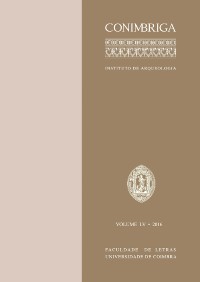Please use this identifier to cite or link to this item:
https://hdl.handle.net/10316.2/41873| DC Field | Value | Language |
|---|---|---|
| dc.contributor.author | Ribeiro, José Cardim | - |
| dc.date.accessioned | 2017-06-01T15:51:50Z | |
| dc.date.accessioned | 2020-09-22T20:53:03Z | - |
| dc.date.available | 2017-06-01T15:51:50Z | |
| dc.date.available | 2020-09-22T20:53:03Z | - |
| dc.date.issued | 2016 | - |
| dc.identifier.issn | 0084-9189 | - |
| dc.identifier.issn | 1647-8657 (PDF) | - |
| dc.identifier.uri | https://hdl.handle.net/10316.2/41873 | - |
| dc.description.abstract | Nos meados do séc. XVIII um lavrador descobriu acidentalmente entre Armês e Lameiras, Sintra – “Zona Oeste” do Município Olisiponense – uma lápide romana com duplo epitáfio gravado em duas colunas paralelas. Deste achado, entretanto novamente perdido, possuímos apenas uma transcrição manuscrita conservada na Biblioteca Nacional de Lisboa (COD. 425 fl. 94), exarada por um anónimo antiquarista que chegou a analisar o monumento in loco. Porém não se apercebeu estar perante uma epígrafe distribuída em duas colunas, copiando pois as letras ao corrido, sem respeitar nem separação de colunas nem, mesmo, de linhas, resultando assim um texto caótico e a priori incompreensível. Hübner (in CIL II 265) tentou reconstituir o original, mas pressupondo que a primeira palavra, que considerou abreviada, era comum aos dois epitáfios, enveredou por um caminho complexo e equívoco que admitia dois antropónimos supostamente paleohispânicos de todo desconhecidos – *Alteciniris (gen.) e *Licassi (gen.) –, bem como o desempenho da augustalidade por escravos. Devido à autoridade do autor de CIL II estas anomalias foram aceites por outros investigadores, alguns de incontestável prestígio, embora também tenham surgido vozes discordantes e mesmo cépticas. Reexaminando o manuscrito setecentista, procurámos nele indícios que nos permitissem, sem preconceitos prévios, elaborar uma renovada restituição da epígrafe original. O resultado conseguido aponta para um texto normal e desprovido de estranhezas ou irregularidades: trata-se tão-só, afinal, dos paralelos epitáfios de dois escravos, Augustinus G(aii) Licini(i) Bassi ser(vus) e Euticus L(ucii) Cassi(i) Alteris ser(vus) – que aliás não apresentam quaisquer cargos mas, apenas, os respectivos elementos onomásticos identificadores. Mais tarde veio a surgir, no mesmo sítio arqueológico, uma nova lápide cujo teor confirma, de algum modo, a nossa anterior reconstituição: trata-se da estela funerária de [-] Licinius Bassus. | por |
| dc.description.abstract | In the mid-18th century a farmer accidentally discovered, between Armês and Lameiras, Sintra – “Western zone” of the municipium of Olisipo – a roman stone with a double epitaph engraved in two text columns side by side. Of this finding, meanwhile lost again, we have only a transcription kept in the Biblioteca Nacional de Lisboa (COD. 425 fl. 94), hand-written by an anonymous antiquarian who observed the monument in loco. He didn’t, however, realize the epigraph was distributed in two columns, and he transcribed the full lines from left to right not minding the separation between columns or even between lines. As a result, he left a chaotic and, at first sight, incomprehensible text. Hübner (in CIL II 265) attempted to reconstitute the original text but, having assumed that the first word, which he deemed an abbreviation, was common to both epitaphs, he took a complicated and equivocal course of reasoning that relied on the proposition of two pretensely palaeohispanic anthroponyms completely unknown: *Alteciniris (gen.) e *Licassi (gen.); and also on an augustal status held by slaves. Due to the authority of the author of CIL II these anomalies were accepted by other investigators, some of high prestige, although others showed some dissent and skepticism. Returning to the original manuscript, we looked in it for clues that might allow, without preconceptions, to elaborate a new reconstitution of the original epigraph. The result is a normal text, devoid of irregularities or inconsistencies: nothing more than the parallel epitaphs of two slaves, Augustinus G(aii) Licini(i) Bassi ser(vus) and Euticus L(ucii) Cassi(i) Alteris ser(vus) – without any religious role but, solely, their identifying onomastic elements. Later, at the same archaeological site, a further inscription appeared that somehow helps to confirm our reconstitution: the funerary stele of [-] Licinius Bassus. | eng |
| dc.language.iso | por | - |
| dc.publisher | Faculdade de Letras da Universidade de Coimbra/Imprensa da Universidade de Coimbra | - |
| dc.rights | open access | - |
| dc.subject | Augustales | eng |
| dc.subject | palaeohispanic anthroponymy | eng |
| dc.subject | epigraphic reconstitution | eng |
| dc.subject | Augustais | por |
| dc.subject | antroponímia paleohispânica | por |
| dc.subject | reconstituição epigráfica | por |
| dc.title | Em torno da revisão de CIL II 265 | por |
| dc.title.alternative | Concerning the revision of CIL II 265 | por |
| dc.type | article | - |
| uc.publication.collection | Conimbriga Vol. 55 | - |
| uc.publication.firstPage | 157 | - |
| uc.publication.lastPage | 191 | - |
| uc.publication.location | Coimbra | - |
| uc.publication.journalTitle | Conimbriga: Revista de Arqueologia | - |
| uc.publication.volume | 55 | por |
| dc.identifier.doi | 10.14195/1647-8657_55_10 | - |
| uc.publication.orderno | 10 | - |
| uc.publication.area | Artes e Humanidades | - |
| uc.publication.manifest | https://dl.uc.pt/json/iiif/10316.2/41873/234612/manifest?manifest=/json/iiif/10316.2/41873/234612/manifest | - |
| uc.publication.thumbnail | https://dl.uc.pt/retrieve/11496326 | - |
| item.fulltext | With Fulltext | - |
| item.grantfulltext | open | - |
| Appears in Collections: | Conimbriga | |
Files in This Item:
| File | Description | Size | Format | |
|---|---|---|---|---|
| cribeiro.pdf | 2.67 MB | Adobe PDF |  |
Items in DSpace are protected by copyright, with all rights reserved, unless otherwise indicated.
